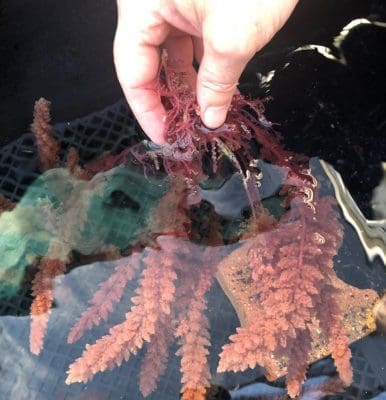The Australian seaweed industry is making waves, with plans to be a $100 million plus industry in the next five years. Investors and entrepreneurs are lining up to get involved in seaweed to make money and make a difference by reducing livestock emissions, improving ocean health and creating jobs in regional areas.
But development will require mobilisation of industry resources to realise the opportunities in sight, a recently-released report suggests.
 “Seaweed offers a huge opportunity for Australia’s blue economy development with the global seaweed market projected at $30 billion by 2025. Australia has no commercial scale seaweed ocean farms and no industry development plan, but rapid change is on the horizon,” says Jo Kelly, chief executive of the Australian Seaweed Institute and lead author of the Australian Seaweed Industry Blueprint.
“Seaweed offers a huge opportunity for Australia’s blue economy development with the global seaweed market projected at $30 billion by 2025. Australia has no commercial scale seaweed ocean farms and no industry development plan, but rapid change is on the horizon,” says Jo Kelly, chief executive of the Australian Seaweed Institute and lead author of the Australian Seaweed Industry Blueprint.
AgriFutures Australia has released the Blueprint (Click here to access a copy) that outlines plans for a $1.5 billion Australian seaweed industry that could employ 9000 people and reduce greenhouse gas emissions by 10pc.
The blueprint suggests that large scale ocean cultivation of the Asparagopsis seaweed species could be fed to at least 30 percent of Australia’s cattle herd by 2025 – just five years away.
“We’ve consulted with industry and identified a $100 million plus opportunity for seaweed over the next five years, with potential to scale to $1.5 billion over the next 20 years. This will create thousands of jobs in regional towns and reduce Australia’s national greenhouse gas emissions significantly,” Ms Kelly said.
The opportunity for an Australian seaweed industry is important from an economic, environmental and social impact lens. Just one of the native seaweeds found off the Australian coast, Asparagopsis, has been shown to reduce methane emissions from cattle to almost zero when added to their feed. This is significant, given around 10pc of greenhouse gas emissions in Australia come from the digestion process of cattle.
Major investors in the project including Andrew Forrest, Woolworths and GrainCorp have backed the Future Feed project, a commercialisation of the Asparagopsis feed additive pioneered by the CSIRO.
The future of the industry will rely on significant expansion into ocean cultivation of native seaweeds and development of high value nutritional products for humans, animals and plants. Major opportunities identified by the report include:
- Large scale ocean cultivation of Asparagopsis seaweed is projected to feed at least 30pc of Australia’s cattle herd by 2025.
- Extension of Kelp farming around fish farms to clean the water and provide additional revenue streams for aquaculture businesses across temperate southern Australia.
- Development of seaweed biofilters to remove excess nutrients and protect the Great Barrier Reef while providing beneficial agricultural products in an innovative circular economy solution.
- Development of offshore integrated food, energy and carbon sequestration platforms for sustainable food production into the future.
- Biodiscovery from native Australian seaweeds to uncover valuable compounds.
- Development of new seaweed products using advanced manufacturing techniques.
The report also highlights the role of State Government aquaculture policy and processes and R&D funding as critical to support early stage industry development.
AgriFutures Australia manager for emerging industries, Tom McCue said the formation of a dedicated research, development and extension plan is a crucial step for the Australian seaweed industry, offering a clear pathway to capitalise on growth opportunities.
“Seaweed has enormous potential and AgriFutures Australia is supporting industry growth as part of our Emerging Industries Program,” said Mr McCue.
“We encourage seaweed producers to consider the opportunities outlined in the Blueprint, and look forward to facilitating ongoing collaboration between research organisations, government and investors to realise the industry vision of becoming a high tech and high value, sustainable industry that will support thriving oceans and coastal communities.”
Click here to access the full report
